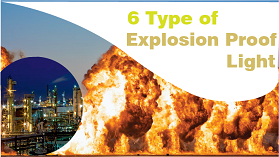What Are Explosion-proof Lights?
In environments where flammable gases, vapors, dust, or combustible fibers are present, safety is paramount. One critical aspect of ensuring safety in such hazardous locations is the use of explosion-proof lights. These specialized lighting fixtures are designed to prevent the ignition of potentially explosive atmospheres, making them a vital component in various industries like oil and gas, chemical manufacturing, mining, and more. In this blog, we will explore the different types of explosion-proof lights available to meet the diverse needs of hazardous workplaces.

1. Incandescent Explosion-Proof Lights
Incandescent explosion-proof lights are one of the earliest types of explosion-proof lighting. They use a heated filament to produce light and are encased in a robust, sealed housing. While they are energy inefficient compared to newer technologies, they are still used in some industrial settings due to their simplicity and reliability.
2. Fluorescent Explosion-Proof Lights
Fluorescent explosion-proof lights are more energy-efficient compared to incandescent lights. They use a different technology where electrical current excites a gas or vapor, producing ultraviolet (UV) light that then interacts with a phosphorescent coating to produce visible light. These lights are often preferred in areas where long-lasting illumination is needed.
3. LED Explosion-Proof Lights
LED (Light Emitting Diode) explosion-proof lights have gained popularity in recent years due to their energy efficiency, durability, and longevity. LED lights use semiconductor technology to produce light, making them highly efficient and long-lasting. They are available in various configurations, including floodlights, high bays, and emergency lights, making them versatile for different industrial applications.
4. High-Intensity Discharge (HID) Explosion-Proof Lights
HID explosion-proof lights, such as metal halide and sodium vapor lamps, are known for their high light output and are suitable for large outdoor areas like refineries and petrochemical plants. They produce light by passing an electrical current through a gas or vapor, creating a high-intensity arc. While they are efficient, they do require warm-up time and have a shorter lifespan compared to LEDs.
5. Emergency Explosion-Proof Lights
Emergency explosion-proof lights are designed to provide illumination during power outages or emergencies. They often incorporate battery backup systems to ensure uninterrupted lighting in critical situations. These lights are essential in hazardous environments where immediate evacuation may be necessary.
6. Portable Explosion-Proof Lights
For situations that require temporary illumination in hazardous areas, portable explosion-proof lights are indispensable. They come in various forms, such as handheld flashlights, work lights, and tripod-mounted floodlights. These lights allow workers to move safely in and out of hazardous zones while maintaining visibility.
In hazardous environments, ensuring safety is paramount, and choosing the right type of explosion-proof light is crucial. Each type of explosion-proof light has its own set of advantages and applications, making it important to carefully assess the specific requirements of your workplace. Whether you opt for traditional incandescent lights, energy-efficient LEDs, or specialized emergency lighting, the goal remains the same: to provide safe and reliable illumination in potentially explosive atmospheres, protecting both personnel and equipment from harm.

